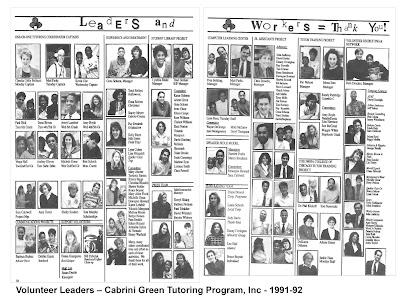When I started leading a volunteer based tutor/mentor program in Chicago in 1975 I held a full-time retail advertising job and the program already had an enrollment of 100 pairs of elementary school age kids and workplace volunteers to begin the school year.
With so little time available to lead the program I had to learn to recruit volunteers to help me and delegate roles for them to take. Over time I learned that many volunteers often over-commit, and for various reasons could not complete the project assigned. Often this led to them disappearing from the program instead of asking for help.
Thus I learned that I needed to follow up, and help volunteers succeed. The result was that volunteers became more committed to the program and often took greater roles in the future.
However, I also learned one more thing. As the leader of the program my vision and commitment was usually greater than that of most volunteers. Because of my constant learning from other programs I often saw opportunities that others did not see. Thus, I had to LEAD. I had to share my visions in ways that volunteers might want to give their time and talent to make those visions a reality.
This led to me coining the formula of "R&D+F&L=Success".
I applied what I learned as the tutoring program grew from 100 pairs to 440 kids and 550 volunteers by June 1992.
Here's a photo showing the leadership committee supporting the 1976-77 program.
Here's a photo showing the leadership team for the 1991-92 program, which had converted to a non profit structure at the start of the 1990-91 school year.
Click on each photo to enlarge. Look at the difference in the number of people involved and the organizational structure between 1976 and 1991-2.
Between 1975 and 1981 I had to recruit a new team of leaders ever spring, with just a few carry-overs from the previous year. We had no paid staff until 1979 when we were able to hire a student from Moody Bible Institute for 10-15 hours a week.
In 1981 we began to change how the committee was organized and recruit leaders for different functional roles. By this time the program size was nearly 200 and more and more volunteers were coming from companies beyond Montgomery Ward (Partly due to downsizing and closing of the MW catalog business. As volunteers went to different companies they continued to tutor, and often began bringing co-workers).
You can see in the second leadership group photos that some volunteers served as formal representatives of the companies they worked at. I used an Excel spreadsheet to record volunteer enrollment and listed the companies they worked at, occupation, and number of years they volunteered. Thus, as I saw groups of five or more from the same company, I began to reach out to veteran volunteers and asked them to become a mentor to co-worker volunteers and a contact point for reaching into the company for donations (we were not a non profit, but still needed food and snack donations, and gifts for the annual Christmas party).
This structure took time to develop. It took more than 15 years. The program was already 10 years old when I became its third leader. At the end of the 1989-90 school year, as we begin creating a non-profit structure, the program already had 300 pairs of kids and volunteers meeting weekly. It still only had a paid staff of three part time college students who worked a total of less than 30 hours a week.
Thus it was a 25 year journey to developing this volunteer leadership structure. The R&D+F&L=Success strategy really worked. I created a concept map to visualize this growth.
 |
| Growth of Tutoring Program - 1965-1992 - map |
In this section of the Tutor/Mentor Institute, LLC site you can find three PDF essays that share my experiences and can help you start and grow a volunteer based tutor/mentor program in Chicago or elsewhere. While these and all of the resources I share are free, I'm available for a small consulting and/or retainer fee, to help you understand and apply these ideas.
 I created the Tutor/Mentor Connection in 1993 (and Tutor/Mentor Institute, LLC in 2011) as we were starting a new program to serve 7th to 12th grade youth who aged out of the first program. The T/MC's vision was to help high quality programs grow in all poverty areas of Chicago. Thus, my goal is that city and business leaders reach out to me for the experiences and ideas I share, and that they provide funds needed for me to collect, organize and share this information.
I created the Tutor/Mentor Connection in 1993 (and Tutor/Mentor Institute, LLC in 2011) as we were starting a new program to serve 7th to 12th grade youth who aged out of the first program. The T/MC's vision was to help high quality programs grow in all poverty areas of Chicago. Thus, my goal is that city and business leaders reach out to me for the experiences and ideas I share, and that they provide funds needed for me to collect, organize and share this information.So far I'm not having a lot of success at this.
If you value the experiences and ideas I've been sharing please consider a contribution to help me continue to do this. Use the PayPal button or mailing address on this page.












No comments:
Post a Comment